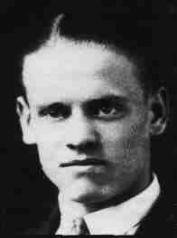|
Television Experimenters.com
History
Philo T. Farnsworth |

Philo T. Farnsworth (at 13 years) |
Probably, the most important invention of early television was the Nipkow scanning disk. The patent papers included a complete closed circuit camera Note that there are no amplifiers in this schematic. This was because the year was 1884, long before the vacuum tube was invented. Paul Nipkow was never able to make his invention work. Others would do that later. The most significant part of the Nipkow invention was the scanning disk itself and the fact that it could not only dissect the image in an orderly manner, but that another disk just like it, could reconstruct the image back into its original form. This was a significant step forward in the advancement of television.
Another important step forward was made by A. A. Campbell Swinton of Scotland. As early as 1908 he recognized and wrote that mechanical means were not capable of operating at speeds that would be necessary for high definition (300-400 lines) television. Only by using cathode rays, which exhibit no inertia, could this be accomplished. In 1911 he firmed up his idea and published this schematic. Cathode ray Television of today, all over the world follows Campbell Swinton's iIdeas exactly. |
The third important step was the first successful camera tube, the Image Dissector invented by Philo T. Farnsworth. Just a farm boy from Utah, pictured above at the age of 13, he spent much of his youth concerned with television. For the most part self educated, he recognized the inherent limitations of the mechanical methods being considered and so went on to develop a totally electronic television system, much like that described by Campbell Swinton some years earlier. When he was 16 years old and in high school, he drew this schematic of the image dissector for one of his instructors. In later years using his image dissector, Philo Farnsworth was the first to demonstrate a complete operating television system that was totally electronic. Also very important, were many of the individual patents that comprised his system.
It's worth noting that Philo Farnsworth was also an effective manager/engineer and you might say he was very efficient in his work. His main competition was the RCA company, including David Sarnoff, Vladimir K. Zworykin and a staff of about 45 good people. In comparison, Philo Farnsworth was usually operating with about 25% of the manpower and at best about 10 % of the RCA budget. In spite of this, he produced a totally electronic system before they could and in doing so, he developed and patented some of the most basic and important ideas in television. The story of Philo Farnsworth, his life and his work, is important and is an absolute "must read" for everyone interested in television history.A book I that I have recently read, and one I recommend you read is: "Philo T. Farnsworth, The Father of Television" by Donald Godfrey (2001). PY
|
*Additional comment
In 1919, the Farnsworth family moved to a farmhouse near Rigby, Idaho. In the attic, Philo found a stack of scientific and semi-technical magazines, including issues of Electrical Experimenter /Science and Invention. Note: I have never seen a complete list of the magazines that were found there, other than to say that of some I have found, that in the issues for May and June 1918 of this magazine, Hugo Gernsback, the magazines owner/editor wrote and published a 2-part article "Television and the Telephot". In the second part of this article, he included and described this drawing of a mechanical/optical camera. Note that the "Sender" optically causes a focused image to pass back and forth and up and down, just as the electron image does in Farnsworth's dissector. As this optical image passes across a small diameter tube that is fixed in place, the tube effectively "samples" the image as it passes by and here again, just as the fixed aperture does in the Philo's dissector. Can you see the resemblance? Could it be that this particular article, which included information about the accomplishments of Rosing and Swinton as well as others, that it might have had a significant effect on Farnsworth and his ideas?? How about that! What do you think??
|
|
I am inclined to believe that Philo saw it, read it and it in fact did influence his work on the dissector. I base this on having read numerous references of how Philo was going out of his way to read everything he could about electrons, magnetic fields and science in general. This all took place in 1919-1920 and the magazines were at this time 1 1/2 to 2 years old... so they fit in the correct time frame. I also base this conclusion on my experience in working with others, in that most ideas, including "new" ones, are based on some previous ideas or experiences. And if all this is true... to me, it shows the true genius in this man. Because no else envisioned what he did or when he did. What Philo did was to connect the dots... before anyone else even saw the dots. He was 13 years old! ... WOW! Amazing! PY
|

All rights reserved.
|